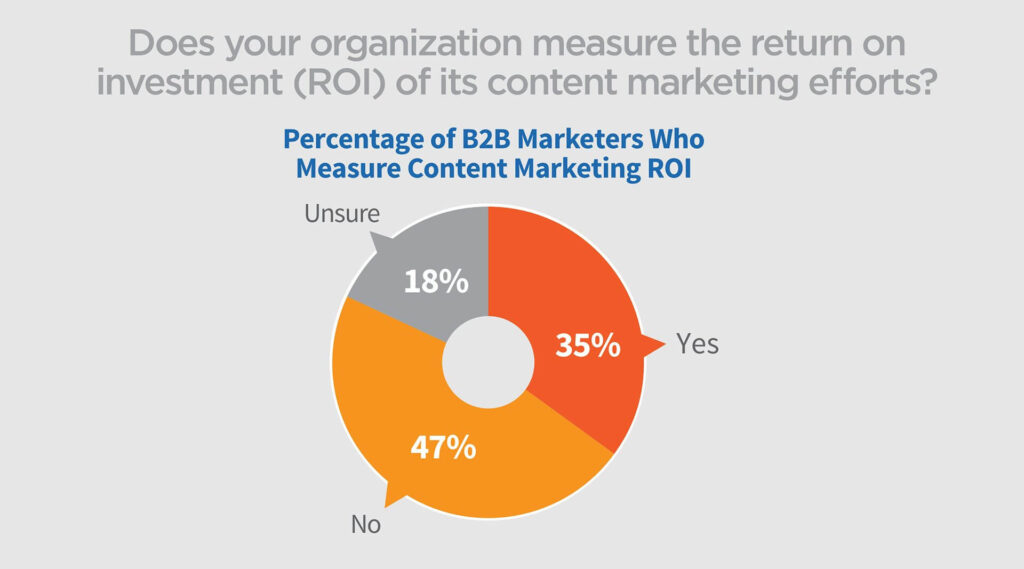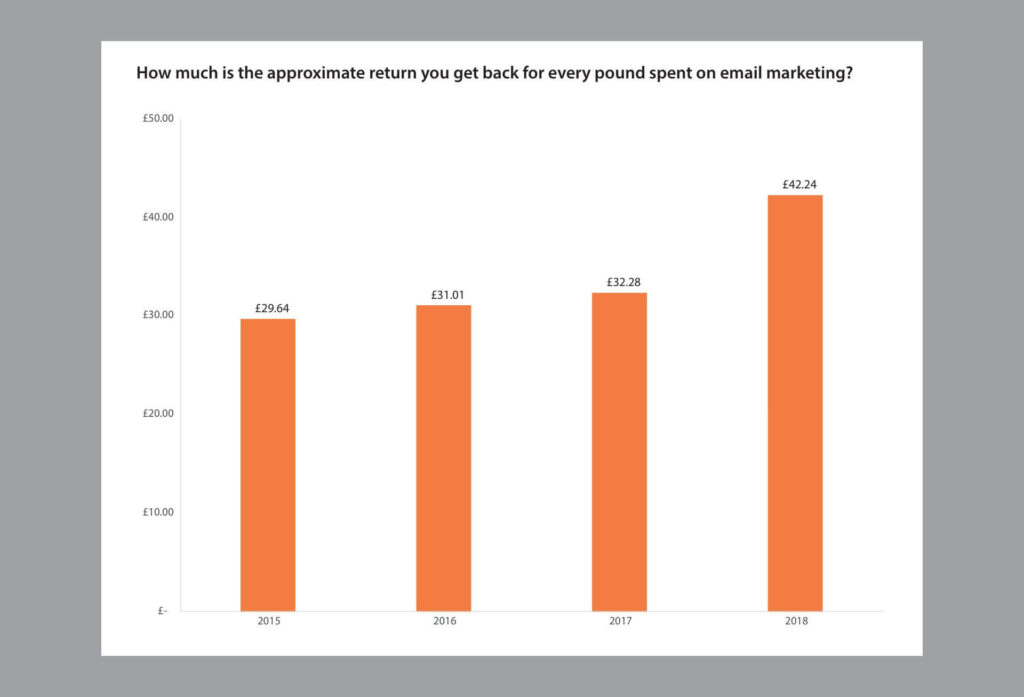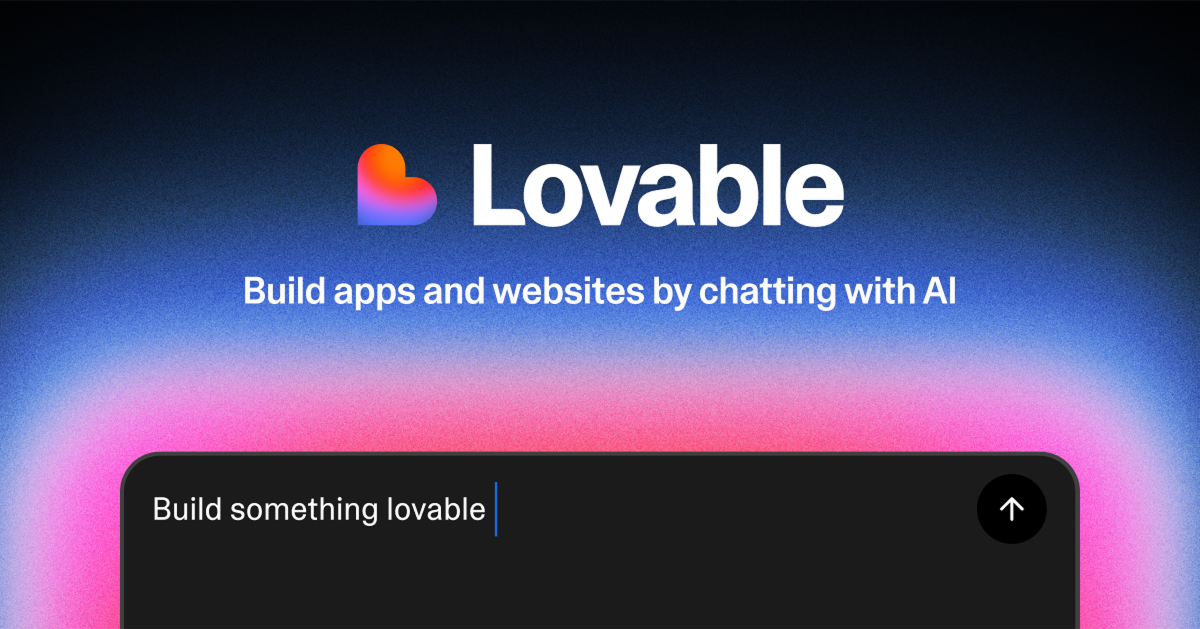Content marketing generates a high return on investment for both B2B and B2C marketers. Data shows that marketers are satisfied with the ROI of content marketing and are seeing a steady ROI increase each year.
To help you make a data-driven decision, I’ve rounded up the most important statistics for 2024 that prove the long-term ROI of content marketing.
Audience Behavior Statistics
Before we jump into the topic of content marketing ROI, let’s delve a little bit into audience behavior statistics. These statistics are very important for your marketing strategy as they can give you valuable insight into the types of content your audience finds important.
Learning what types of content your audience finds most relevant in every step of the marketing funnel can help you use content marketing to reach out to them in an effective way.
Demand Gen’s Report on B2B Buyers’ preferences from 2018 revealed that customers are becoming increasingly more selective in the content they consume and tend to rely on trustworthy sources.
- 71% of B2B buyers said that they consume blog content during a purchase.
- 64% of respondents stated that they consider podcasts a valuable type of content in the early stage of their buyer’s journey.
- 47% of respondents stated that they value webinars in the mid-stage of their buyer’s journey.
- Analyst reports, webinars, and interactive content are considered the most valuable types of content for consumers in the later stage of the buyer’s process.
- 40% of respondents stated that they consume 3–5 pieces of content before reaching out to a salesperson.
- 65% of content consumers stated that they prefer content from prominent industry influencers.
- Case studies (79%), webinars (66%), video (49%), and interactive content (36%) are the most preferred types of content for B2B buyers.
- Nearly 50% of buyers watch product videos before making a purchasing decision.
- 67% of respondents reported that the quality of a product image influences their purchasing decision.
Content Marketing ROI Stats
Every business needs to calculate the ROI of every facet of its content strategy to see what works and what doesn’t. After all, savvy businesses don’t operate on blind guesses – they strategize based on solid data.
However, if you’re still brainstorming your strategy, the wealth of stats on content marketing ROI and related metrics that are already available can be a good starting point when you’re trying to gauge what type of content to invest in. Checking what the majority of your competitors are investing in is always a good tactic.
B2B Content Marketing ROI Statistics
The CMI’s reports on B2B content marketing attest to the importance of the role content marketing has played for brands in the last decade.
Their report for 2020 showed that marketers are highly focused on producing content but are making changes to the ways they measure, distribute, and create it.
The stats below prove that B2B marketers are becoming more confident with their content strategy, with 95% of them stating that their organization represents a valuable and trusted content resource to their audience.

What’s more, the Content Marketing Institute’s report for 2018 showed that 89% of the most successful B2B marketers have a content marketing strategy.
- 37% of B2B marketers have a documented content marketing strategy.
- 91% of interviewed B2B marketers said that their organization uses content marketing.
- 35% of interviewed B2B marketers stated that they measure content marketing ROI.
- 47% of B2B marketers stated that they don’t measure content marketing ROI. 38% of them said that the reason behind this is that they don’t require formal justification; 37% said that they need an easier way to measure ROI; 27% don’t know how to measure content marketing ROI.
- 70% of interviewed marketers said that they can demonstrate how content marketing has grown their number of leads and increased customer engagement.
- Social media posts (95%), blog posts (89%), and email newsletters (81%) are the top three types of content B2B marketers have used in the past 12 months.
- 34% of interviewed marketers expect their content marketing budget to increase in 2020.
- HubSpot’s State of Inbound Report of 2018 showed that marketers who prioritize blogging are 13x more likely to drive positive ROI. (Source)
- 43% of respondents stated that their company is in the mature state of content marketing maturity. (Source)
B2C Content Marketing ROI Statistics
The CMI’s 2019 report on B2C marketing revealed that creating brand awareness is a top goal for B2C marketers. Cultivating relationships with customers is another great concern, with 82% of marketers stating that their organization is interested in creating content that builds loyalty with customers.
The survey suggested that in order to keep creating content that brings a high return on investment, in the future, B2C marketers need to focus on content that nurtures their audience and generates leads.
- In 2018, 57% of the interviewed B2C marketers stated that they expected to boost their content marketing budget in 2019. 29% of them said they expected an increase of 9% compared to 2018.
- 57% of B2C marketers measured content marketing ROI.
- Content creation (56%) and paid content distribution (37%) are the two areas in which B2C marketers increased their budget in 2018.
- 68% of interviewed marketers stated that they use paid methods to distribute content.
- 64% of B2C content marketers stated that their company is extremely committed to content marketing.
- Only 33% of B2C content marketers have a documented content strategy.
- 40% of B2C marketers think that their company’s ability to make use of content marketing technologies is intermediate.
- Social media analytics (85%), email marketing software (77%), and analytics tools (71%) are the top three technologies that B2C marketers are using to manage their content marketing efforts.
- 68% of B2C marketers that use content marketing technologies stated that they help them gain a better insight into how content is performing.
Email Content Marketing ROI Statistics
Are you having doubts about whether email marketing is still a relevant marketing technique? There’s no need for those assumptions – email marketing is still rocking the charts.

In 2015, email marketing generated $38 for every dollar spent, and one in five companies reported an ROI of over 70:1. But what about now?
The DMA Marketer Email Tracker for 2019 showed that in 2018 marketers expected their email campaigns to perform better the following year. And 58% of the interviewed marketers stated that they expected that their ROI would continue to increase.
- The DMA Marketer Email Tracker for 2019 showed that 62% of interviewed marketers were measuring the ROI of their email marketing campaigns. The report showed that marketers were more confident in their ability to measure ROI in 2019. 71% of B2B marketers were satisfied with their ability to calculate ROI, whereas B2B organizations (48%) needed a longer time to measure their performance.
- The return on investment for email marketing in 2018 stood at $42, which is an increase of $10 from the DMA’s previous report.
- 76% of marketers reported an increase in open rates and 75% said click-throughs have been higher over the last 12 months.
- The lifetime value of individual addresses was calculated to be worth $37 in 2018. Data showed that the lifetime value of email addresses was greater for B2C marketers ($41) than for B2B marketers ($35).
- 67% of marketers stated that 20% of their marketing budget was spent on email marketing in 2018.
- The top three industries that generate the highest ROI from email marketing are travel, tourism, and hospitality.
- Email marketing campaigns that contain video content generate 96% higher click-through rates than campaigns that don’t use video content.
Email Marketing Trends That Increase ROI
Litmus has surveyed hundreds of brands to find out which email marketing practices lead to a higher return on investment. Here are the findings:
A/B Testing
Brands that use A/B tests in their email marketing campaigns drive an ROI of 48:1, compared to an ROI of 35:1 for those who don’t make use of A/B tests.
Double Opt-ins
Brands that incorporate double opt-ins in their email marketing campaigns drive an ROI of 45:1, compared to an ROI of 40:1 for those who use single opt-ins.
Dynamic Content
Brands that implement dynamic content often or always drive an ROI of 44:1, compared to an ROI of 36:1 for those who never use dynamic content.
Live Content
Brands that use live content in their emails often or always generate an ROI of 50:1, compared to an ROI of 39:1 for those who never use live content.
Animated GIFs
Brands that add animated gifs in their email marketing campaigns generate an ROI of 46:1, compared to an ROI of 38:1 for those who never use animated gifs.
External Email Analytics Tools
Brands that make use of external email analytics tools provided by their email service generate an ROI of 48:1, compared to an ROI of 39:1 for those who never use email analytics tools.
Extensive Pre-send Checklist
Brands that use an extensive pre-send checklist generate an ROI of 48:1, compared to an ROI of 38:1 for those who don’t use pre-send checklists.
Visual Content Marketing ROI Statistics
Currently, visual content is huge, and video, in particular, is becoming a giant player. It’s estimated that video drove $28 billion in revenue in 2024, and this lucrative industry shows no signs of stopping.
There are some exciting predictions about the future of video, with marketers expecting that it will reach $47.89 billion in revenue by the end of 2024.
- 75% of content marketers stated that they drive better ROI when they add visuals in their content.
- Animoto’s Social Media Report for 2020 showed that 91% of marketers are satisfied with the ROI of video marketing on social media.
- 93% of brands landed a new customer by posting a video on social media.
- Adding video content on your website can drive an 80% increase in conversion rates.
- 83% of interviewed marketers were satisfied with the ROI of video marketing. 82% of them stated that video marketing is their key marketing strategy.
Now, go out there and make better decisions based on data.

